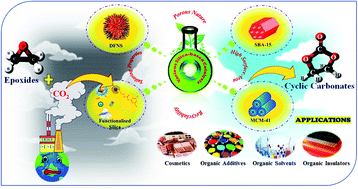Recent developments in state-of-the-art silica-modified catalysts for the fixation of CO2 in epoxides to form organic carbonates
Abstract
The discharge of CO2 into the atmosphere has become a crucial issue for mankind and a great threat to the environment due to the escalating consequences of global warming. Accordingly, the potential utilization of CO2 for the synthesis of sustainable value-added products is significant. Chemical fixation of CO2 is one of the most promising methods to produce useful chemicals such as cyclic carbonates. Thus, the focus of the current review is to present the recent progress towards the cycloaddition reaction of CO2 with epoxides to form cyclic carbonates using various silica-modified materials as promising state-of-the art heterogeneous catalytic systems. This review aims to provide vital insights and understanding based on four different classes of silica-modified catalysts, which include dendritic fibrous nanosilica (DFNS), MCM-41 (Mobil Composition of Matter No. 41), SBA-15 (Santa Barbara Amorphous-15), and different ionic liquid-functionalized, metal-containing and miscellaneous silica-based catalysts. Each class of silica-modified catalysts is reviewed and discussed with specific focus on their synthesis, physicochemical properties and catalytically active sites. Further, the beneficial aspects of silica-based materials containing different functionalities and the related reports published in the past decade are discussed for the chemical fixation of CO2 with epoxide to form cyclic carbonates. High surface area silica-modified catalysts and their attached functionalities exhibit highly ordered nanopores and highly crystalline nature due to their diverse properties, which enable co-operative catalysis, thereby resulting in superior conversion, selectivity and better yield compared to other homogeneous catalysts. The influence of the reaction parameters, synergistic interactions between the silica catalyst and CO2 and profound mechanistic details with respect to the cycloaddition reaction are given specific attention throughout the different sections and described together with descriptive tabulations and figures. Finally, future opportunities with respect to the development of advanced silica-modified catalysts for CO2 conversion to value-added products are highlighted.

- This article is part of the themed collection: Sustainable Energy and Fuels Recent Review Articles


 Please wait while we load your content...
Please wait while we load your content...